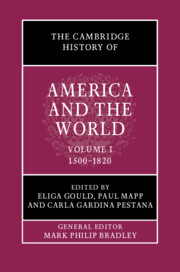Book contents
- The Cambridge History of America and the World
- The Cambridge History of America and the World
- The Cambridge History of America and the World
- Copyright page
- Contents
- Figures
- Maps
- Contributors to Volume I
- General Introduction: What is America and the World?
- Introduction: What Does America and the World “Mean” before 1825?
- Part I Geographies
- Part II People
- 5 Jews, Muslims, Pagans, and America
- 6 Statelessness, Subjecthood, and the Early American Past
- 7 Mobility and the Movement of Peoples
- 8 How Native Americans Shaped Early America
- Part III Empires
- Part IV Circulation/Connections
- Part V Institutions
- Part VI Revolutions
- Index
7 - Mobility and the Movement of Peoples
from Part II - People
Published online by Cambridge University Press: 12 November 2021
- The Cambridge History of America and the World
- The Cambridge History of America and the World
- The Cambridge History of America and the World
- Copyright page
- Contents
- Figures
- Maps
- Contributors to Volume I
- General Introduction: What is America and the World?
- Introduction: What Does America and the World “Mean” before 1825?
- Part I Geographies
- Part II People
- 5 Jews, Muslims, Pagans, and America
- 6 Statelessness, Subjecthood, and the Early American Past
- 7 Mobility and the Movement of Peoples
- 8 How Native Americans Shaped Early America
- Part III Empires
- Part IV Circulation/Connections
- Part V Institutions
- Part VI Revolutions
- Index
Summary
With good reason, the historian Bernard Bailyn – writing near the end of the twentieth century – described the “peopling of British North America” as “the most sweeping and striking development in this millennium of Western history.” The movement of people from one side of the ocean to the other “transformed at first half the globe, ultimately the whole of it, more fundamentally than any development except the Industrial Revolution.” He was not alone in believing this. Bismarck, as he reminded us, had called the migration of so many “the decisive fact in the modern world.” The movement of men and women from the Old World to the New, and this is fairly uncontestable, made British North America and then the United States distinctive, creating a diverse cultural landscape, just as the flow increased the productive capacity of the West in ways that no one could have anticipated. Migration produced untold wealth, expanded the territorial footprints of colonies and then states, remade the political economy and the social fabric of the broader Atlantic, and would make the United States one of the most powerful nations in the world. The story of migration is the story of America.
- Type
- Chapter
- Information
- The Cambridge History of America and the World , pp. 161 - 178Publisher: Cambridge University PressPrint publication year: 2022



